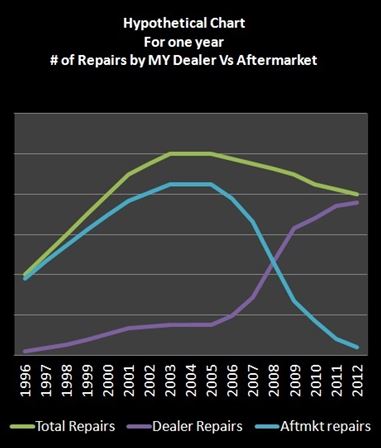Monetizing Telematics
Charlie Gorman - ETI
- October, 2013
 Everyone
knows that vehicle telematics is on its way to be one of the most
significant technologies to hit the automotive industry in a very long
time. And, everyone knows that they need to be involved somehow,
but are not clear what that means. It seems that there is no
shortage of experts who claim to know the end game, but are struggling
to figure out the first steps. The future market for telematics
products is huge and yet everyone currently involved is struggling to
find that magic combination of telematics goodies that makes consumers
line up as if it were a new i-phone. Everyone
knows that vehicle telematics is on its way to be one of the most
significant technologies to hit the automotive industry in a very long
time. And, everyone knows that they need to be involved somehow,
but are not clear what that means. It seems that there is no
shortage of experts who claim to know the end game, but are struggling
to figure out the first steps. The future market for telematics
products is huge and yet everyone currently involved is struggling to
find that magic combination of telematics goodies that makes consumers
line up as if it were a new i-phone.
I have watched presentation after presentation where the speaker
proclaims, with incredible confidence, to know what motorists want, but
then later cannot make a business case for implementation. Either
his or her idea is technically too difficult and expensive to
accomplish, or research has shown that motorists are not willing to pay
for it.
So monetizing telematics has become an important subject in
itself. In some ways it may be the most important topic because
without a free-enterprise engine to power it, telematics is not going
to go anywhere.
When it comes to monetization, many of the articles I have read turn to
the smartphone industry for comparison. This is good because the
similarities are compelling and the smartphone can be a key component
in a vehicle telematics configuration.
Smartphones are devices that form a telematics link between its user
and the services he or she is interested in. It acts as a sensory
device capable of capturing sound, video, global position, motion,
etc. It is an input device capable of gathering information from
other sensory devices. For example, the credit card reader that plugs
into the headphone jack. The smartphone is also an output device
capable of displaying graphics, video and text; producing sounds; and
connecting to other output devices.
Simply having a smartphone in your pocket provides motorists a certain
level of vehicle telematics. Vehicle position, driving
directions, speed, voice communications and every other telematics
functions common to both vehicles and smartphones. Even a vehicle
crash can be detected by a smartphone. A simple app using the
phone’s accelerometer could be used to report potential crashes.
If a phone can do all of this, who needs vehicle
telematics? If a phone can do all of this with free apps,
does it at least partially explain the difficulty everyone in
automotive telematics is having with monetization?
But there is one aspect of vehicle telematics that only the vehicle can
provide. Just like the smartphone, the vehicle is a
computer. But this computer contains hundreds of sensors, modules
and actuators that gather data about the vehicle and implement
commands. Basically the vehicle is an input/output device.
When connected to a diagnostic application either in a smartphone or
any other device capable of remotely connecting to the internet, all of
the vehicle’s diagnostic and maintenance information can become
available to whomever the vehicle owner wants to share it with.
The problem is that vehicle manufacturers only have access to their own
diagnostic information and no one else’s. To what extent are they
willing to provide their customer with a similar telematics experience
that those customers already have with their smartphone usage?
Unlike the smartphone industry, where the consumer can use any brand of
phone they like with apps that work across many platforms, OEMs each
have their own API, so the customer has no guarantee of consistency of
use.
Some vehicle manufactures will not provide connectivity information to
any company that may compete with them in the telematics market and
third-party app developers have little interest in investing time and
resources into apps that can only be used in one brand. Also,
research has shown that in the smart phone market the ratio of free
apps to paid apps is 400:1 with the monetization coming from in-app
advertising, a model which is unlikely to transfer to the auto market
mainly due to safety concerns. The market then, for auto apps other
than navigation, traffic, and audio, is therefore limited.
Thirty percent of customers expect the cost of the connected car should
be included in the overall price of the vehicle, while only a fifth of
those surveyed felt that monthly contracts or a pay-per-use model would
be viable. That isn’t a good sign for the OEM’s profit margins.
So who will pay for telematics?
Vehicle Manufacturers, with a couple of exceptions, are reluctant to
share their own technology. Third-party app developers are unwilling to
expend the effort on something that doesn’t give them a return on
investment. And customers expect telematics to be included in the cost
of their vehicle.
Quoted in an article from Telematics Update, Brian Inouye, National
Manager Advanced Technology, Toyota, puts it this way: “We need a way
to communicate directly with the end user. If the customer wants
to assign their data to a particular establishment then we can enable
that. The customer becomes a happier person. This could be
a differentiator.”
This is an important statement and in my opinion 100% accurate, although probably in a different way than mr. Inouye intended.
Vehicle manufacturers should not worry about telematics except to
provide the simplest, safest and most complete third-party interface to
their vehicles. Of course they will develop their own products
and they will have value for a while, but as the vehicle age’s app
developers in conjunction with systems integrators will develop the
market for the time when these vehicles will need the most service and
maintenance.
As the chart below suggests, OEMs only have access to the repairs and
maintenance early in a vehicle’s life. Once the vehicle reaches a
certain age, aftermarket service facilities take over the
repairs. It is in the vehicle manufacturer’s best interest to
allow easy access to telematics data in support of third party
telematics solutions, or risk unhappy motorists.
 The repairs required for older vehicles are different than the repairs
required on newer vehicles. OE service manuals are updated
through TSBs for a while but once a vehicle reaches a certain age these
TSBs stop coming. Some aftermarket service information providers
base their diagnostics on what is actually happening to older vehicles
as they age. In many cases this makes for better diagnostics. The repairs required for older vehicles are different than the repairs
required on newer vehicles. OE service manuals are updated
through TSBs for a while but once a vehicle reaches a certain age these
TSBs stop coming. Some aftermarket service information providers
base their diagnostics on what is actually happening to older vehicles
as they age. In many cases this makes for better diagnostics.
On board telematics systems have a tendency to become obsolete long
before the vehicle’s transportation value is used up.
Obsolescence, in this case, includes more than complete failure.
It also means being passed up by newer, better, faster
technology. For example, old i-phones still work, but few people
want one. Even if updated software is made available, old
hardware will not be upgraded.
There are other important examples. OEM scan tools become
obsolete at some point. We have seen over and over again where
certain OEM scan tools are no longer made or offered. In these
cases, aftermarket scan tools may be the only solution for these older
cars. The same will probably be true for factory embedded
telematics.
Many multi-brand fleets want to have one telematics solution that
covers all of their vehicle brands. Automakers will never be able
to offer multi-brand solutions.
Ultimately there will be plenty of business for everybody in the
Telematics Market. Motorists will have an interest in proprietary
OEM telematics when the vehicle is young because it will give them
access to warranty and other dealer services, but as the vehicle ages
they will want choice that can only be provided by a third party.
Automakers will still gain because it will create brand loyalty
throughout the life of the vehicle.
Apps
will have to be very low cost or even free. Monetization
will come from service groups, parts chains, service information
providers, equipment companies, etc. providing lead generation to
service facilities within their networks. Motorists will decide
what apps to download based on the affiliation of their favorite
service facility. The more open vehicle manufacturers make their
systems to third party developers, the more likely apps will be
developed and the more favorable their vehicles will be viewed by
customers.
|
|
